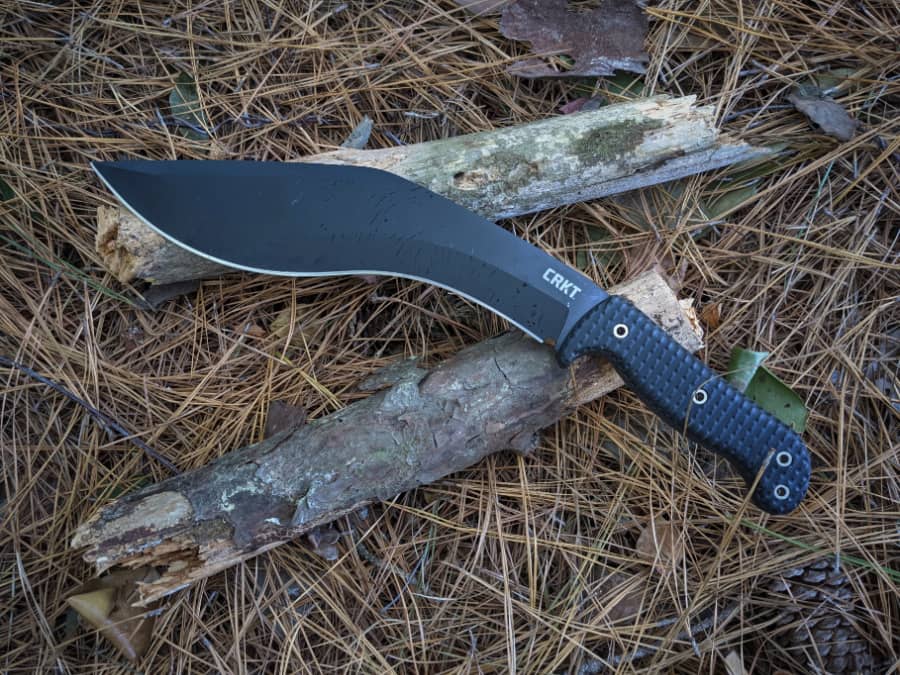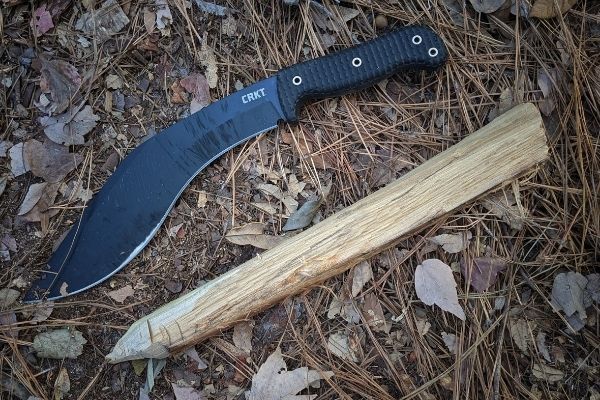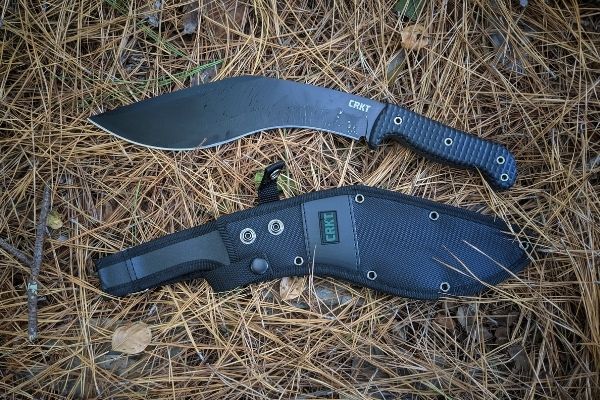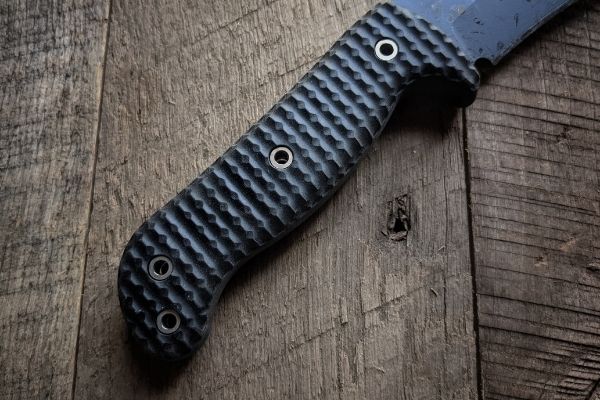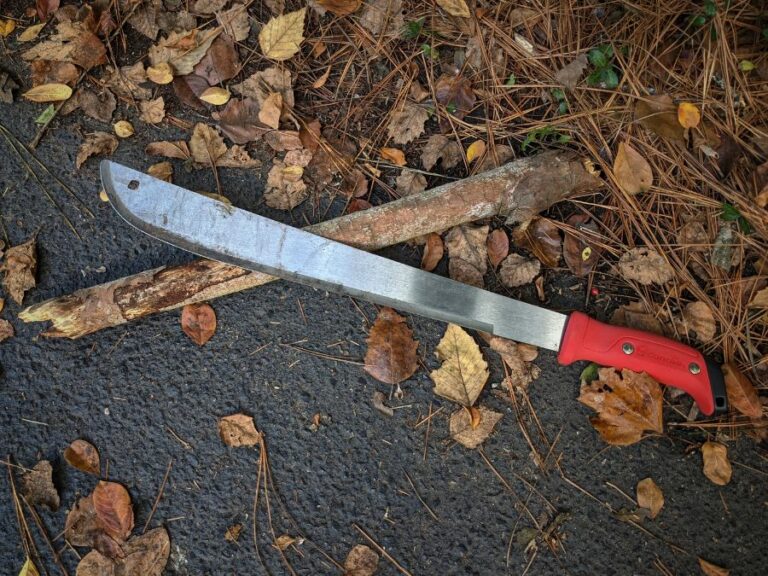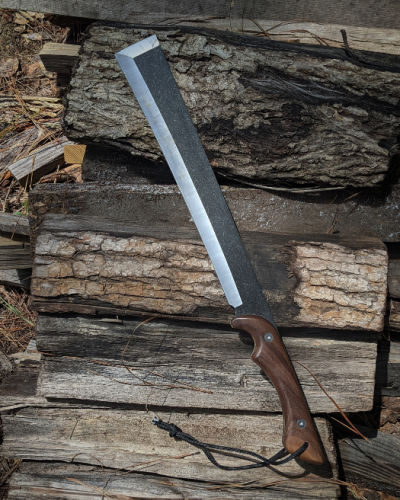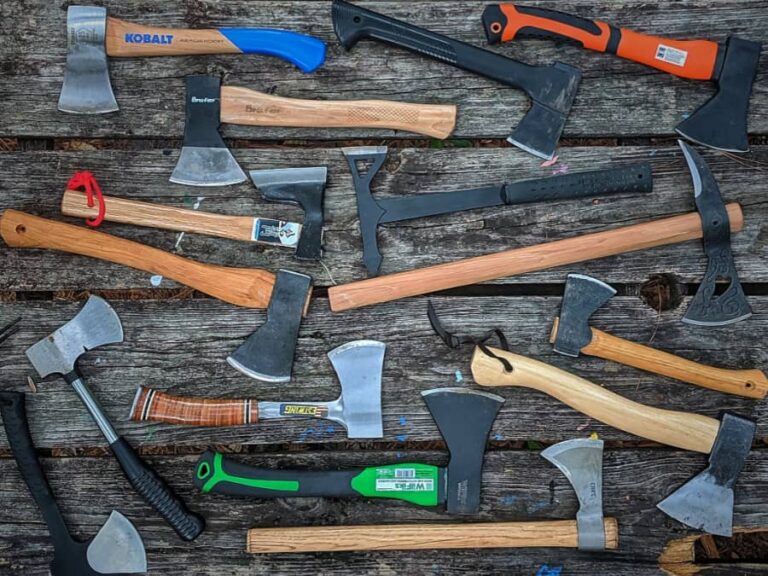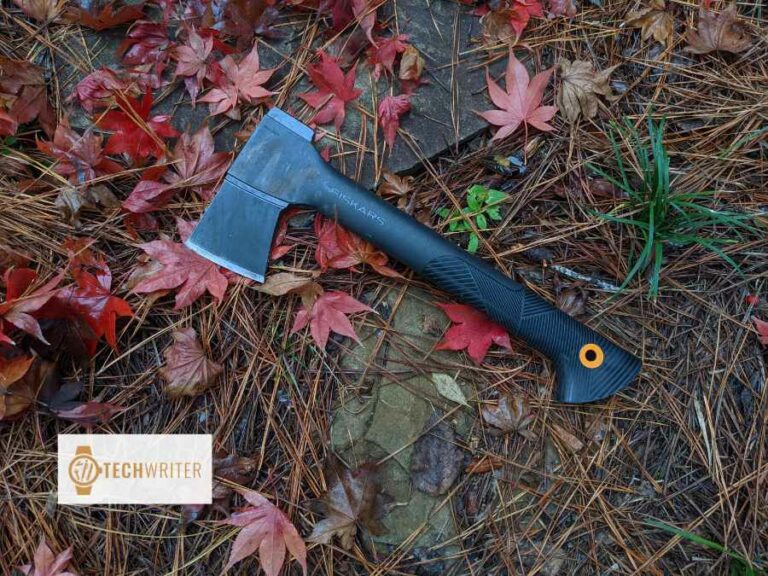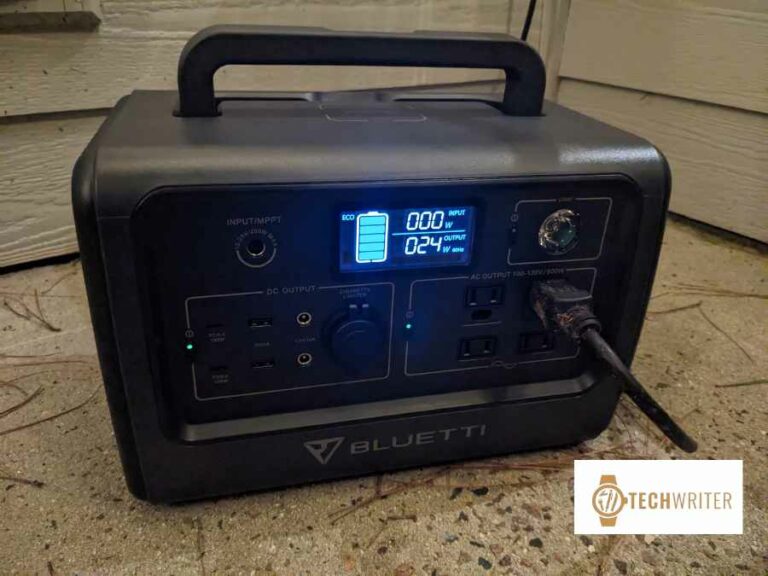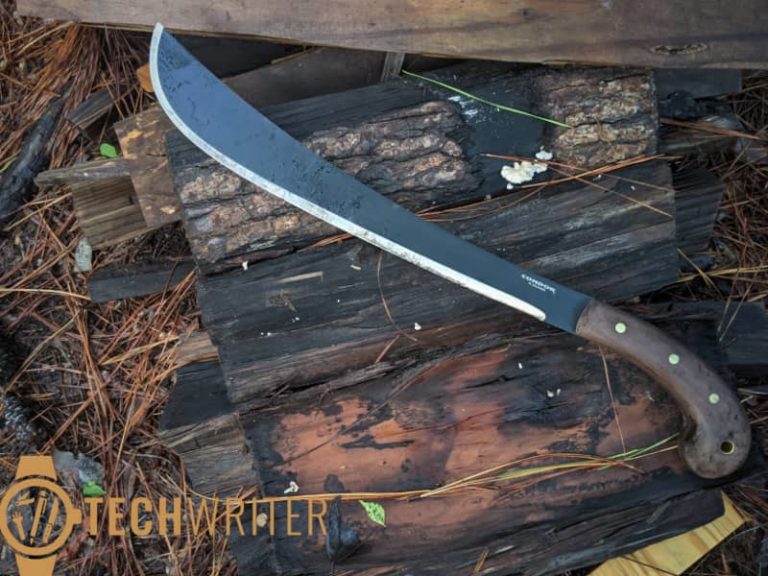CRKT Kuk Review
Quick Overview:
The CRKT Kuk is a budget friendly kukri with some nice features. It feels good in the had, performs well and has the looks to back it up. It cut, sliced and chopped it’s way through our tests to earn a good buy rating from the team.
Our Recommendation
Pros:
- Budget Friendly
- Good Build Quality
- Decent Sheath
Cons:
- Blade Steel Just Average
- Handle only OK after lots of use
In recent months, I’ve been testing out a few different knives in what I call the ‘machete extended family’. The Kukri knife from CRKT (Columbia River Knife & Tool) is the latest to arrive at my doorstep, and I’m excited to get chopping.
Officially dubbed the CRKT Kuk, this is a formidable knife that handles yard work and bushcraft tasks with ease, and also makes for a formidable self defense tool. Also, as everyone who reviews this knife seems obligated to point out, the work ‘kuk’ means something naughty in Norwegian… so there’s that.
What is a Kukri, Exactly?
Anyone who’s not a total knife nerd could be forgiven for wondering just what a kukri is. The kukri is a type of machete-like sword native to Nepal and parts of India. Traditionally, a kukri is intended to be a multipurpose knife, equally useful for hand-to-hand combat and general manual work purposes.
Known to date back to at least the 1500s, the hallmark feature of a kukri is its deeply recurved blade. Kukris have long been carried by Gurkha warriors, and are still standard issue in certain units of the Nepalese and Indian military.
The CRKT Kuk is not, strictly speaking, a 100% authentic kukri. It’s what you might call ‘kukri-inspired.’ The blade’s unique curvature—designed by Ryan Johnson of RMJ Tactical—pays homage to a classic kukri shape while incorporating a few modern touches. At the end of the day, the concept that most closely ties the Kuk to its forebears is that it’s a knife with many uses.
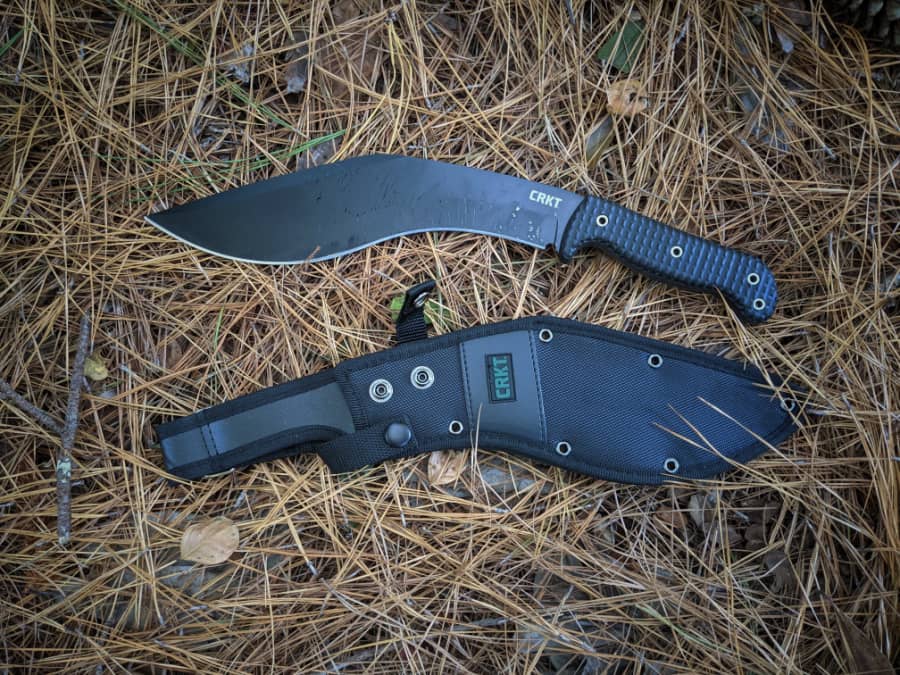
Measurements and Specs
The CRKT Kuk is advertised as a 16-inch knife with a 10-inch fixed blade. More precisely, it measures 15.88″ from tip to tip, and the blade measures 10.56″. The Kuk has a full tang blade, which I consider to be pretty essential in a knife this size. It’s 0.14″ thick at the spine, which gives it the strength for heavy-duty chopping.
Tipping the scales at 14.7 oz, the Kuk is definitely on the lighter end of the spectrum and it really is quite agile for its size. Many knives of similar proportions weigh a pound or more, so the Kuk feels fairly light in the hand, especially if you’re accustomed to a heftier machete. The sheath adds an additional 5.5 oz of weight to the Kuk.
SPECIFICATIONS from CRKT
| Blade Length | 10.56″ (268.30 mm) |
| Blade Edge | Plain |
| Blade Steel | 65Mn Carbon Steel |
| Blade Finish | Powder Coat |
| Blade Thickness | 0.14″ (3.53 mm) |
| Overall Length | 15.88″ (403.23 mm) |
| Weight | 14.70 oz. (416.74 g) |
| Handle | Core – Polypropylene; Overmold – Thermoplastic Rubber |
| Style | Fixed Blade Knife w/Sheath |
| Sheath Material | 1680D Woven Polyester; Black; Insert – Polyethylene; Black |
| Sheath Weight | 5.50 oz. (155.92g) |
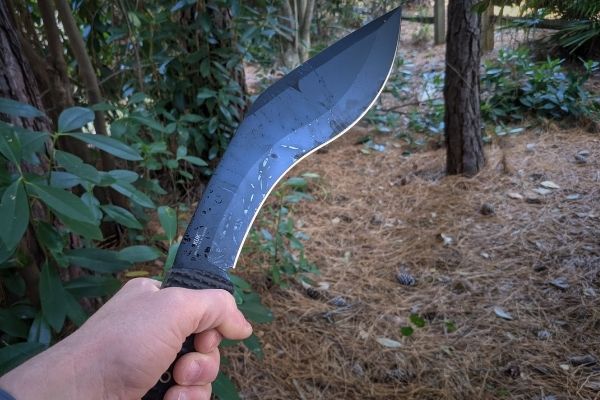
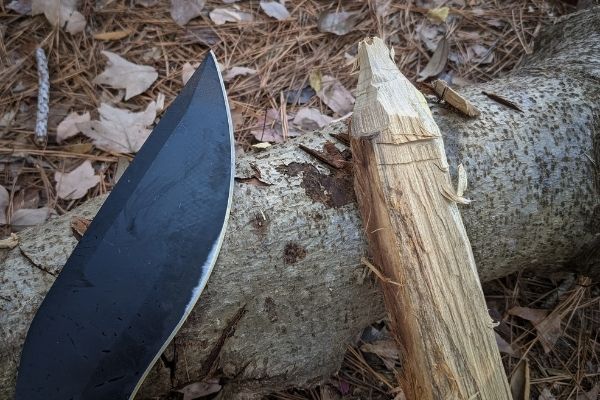
Blade Shape and Steel
The hallmark of a kukri is its recurve blade, and the CRKT Kuk makes ample use of this feature. True to its namesake, the cutting edge of this knife features a significant ‘belly’ close to the tip, which transitions to an inward curve closer to the handle.
With a full flat grind and black powder coated finish, it’s a unique looking knife but also a functional one. Mine came quite sharp right out of the box. We’ll get into specifics about what this knife is good for and why a little down the line, but for now let’s just say the Kuk is a versatile tool that blends form and function very nicely.
The Kuk is made of 65Mn steel, which is a mid-carbon steel. It’s actually the same steel used in the Kershaw Camp 10, another great knife with a similarly kukri-inspired blade. This is Chinese steel, and it offers a pretty good balance of flex and hardness. It holds an edge well.
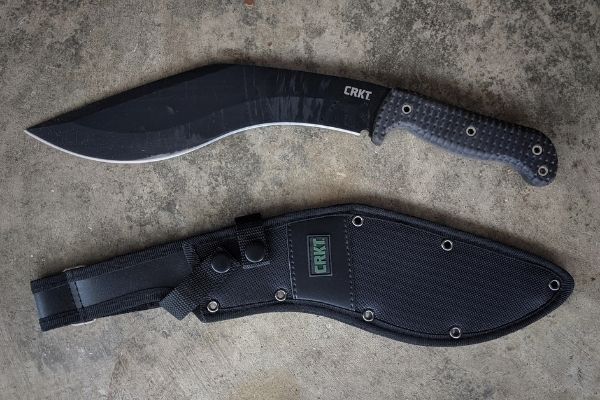
Handle and Sheath
As we all know, the blade isn’t the only important part of a knife. The handle of the CRKT Kuk is double injection-molded thermoplastic rubber with textured grip. If you’re looking at images of this knife online, it might be hard to get a real sense of what the handle really feels like in hand.
I find it to be very comfortable and extremely ‘grippy’ even in wet conditions. The handle makes this knife much easier to wield effectively, and the lack of slippage is a huge plus from a safety standpoint. I’m a big fan of this handle. Lanyard holes are positioned toward the rear of the handle, and could easily accommodate your paracord of choice.
The only downside here is without gloves, prolonged use did start to hurt my had a bit. Not in easier tasks such as carving or slashing brush, but heavy chopping. The texture on the handle is great, but in a bare hand under very hard use it felt uncomfortable. Wearing gloves solved this instantly.
The sheath that comes with the Kuk is a fairly basic one. It’s made of soft woven 1680-Denier Polyester, which I expect will weather wear-and-tear nicely over time. Dual snap straps keep the knife securely inside the sheath, and the Velcro belt loop feels secure. Again, there’s nothing fancy about any of this, nor would I expect there to be. You could replace this with a nice leather sheath if you were so inclined.
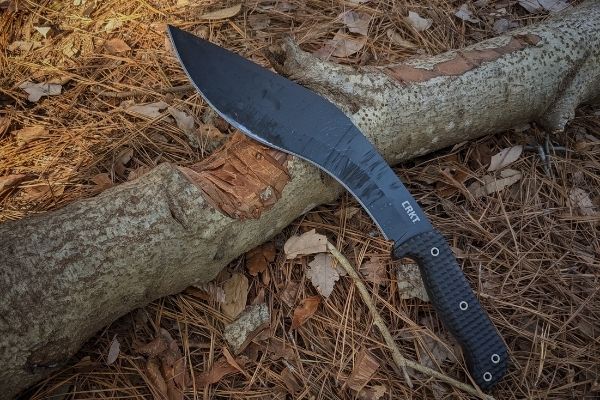
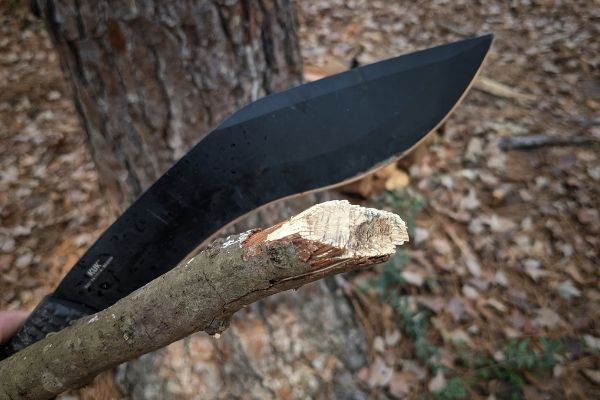
The CRKT Kukri in Action
Ultimately, the big question with any knife is, ‘what can you do with it?’ No matter how stylish and well-made a blade may be, it’s only as good as its real-world applications. Lucky for me, the fun part of reviewing a knife like this is getting to actually try it out.
Again, the idea behind a traditional kukri is to carry one knife that can do pretty much anything you need it to, and the design of CRKT’s Kuk bears that out. It’s equally adept as a survival knife as it is for everyday yard work and bushcraft. I can’t personally speak to its bona fides as a combat blade, but I can tell you that if somebody came after me with one of these things, I would run.
In all seriousness, the KRKT Kuk is an excellent knife to have handy in a situation where self-defense is required, whether that means warding off a wild animal or defending yourself against human attackers. The same characteristics that make it excel in these circumstances also make it a great bush tool.
First and foremost, the recurve blade is not just for show. This particular blade style has some real advantages. The inner curve of the blade serves to guide and gather materials along the edge rather than push them away, and the belly of the blade has some real bite to it. When this blade grabs into something, it doesn’t want to let go.
That makes the Kuk a highly efficient slasher and chopper. It’s great for traditional machete jobs like clearing a path through thick brush. The blade makes fast work of soft vegetation, and will also break down thicker, woodier stuff with ease.
A knife like this isn’t really my first choice for heavier-duty chopping, but it can definitely handle tougher stuff. In the context of being a survival/bushcraft knife, It’s not always about having the best tool for each job, but rather one tool that can do a lot of different things if it has to. This is definitely the latter. It’s not so much a specialist as a Jack-of-all-trades.
The inner part of the recurve blade closest to the handle is pretty good for more delicate tasks like carving, whittling or shaving tinder. The blade is also sturdy enough that it can be used to baton firewood, though I would be cautious about trying to split really thick logs with it.
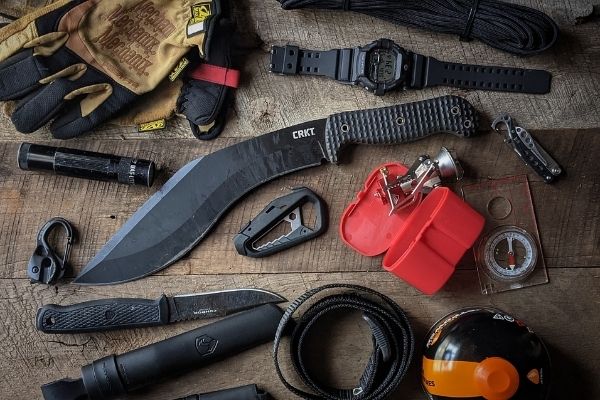
A Great Kukri for the Money
Last but not least, let’s talk about price. On a good day, you can pick up a CRKT Kukri for less than $50, which is a pretty incredible deal when you consider how much knife you’re getting. I would definitely consider this a good value.
The knife that I find myself repeatedly comparing the Kuk to is the Camp 10 knife from Kershaw. These are two similar (and similarly-priced) knives that I’ve become a big fan of, and my preference between the two changes from day to day. Generally, I feel a little more confident in the Kershaw for heavy-duty work, but they’re both high quality blades with identical steel composition and comparable cutting edges.
I have to give the Kuk points for being the more lightweight of the two, and ultimately a more comfortable carry. It has a more pronounced recurve as well. This is a really excellent survival knife that one could also use for self defense if the need should arise.

Blair Witkowski is an avid watch nut, loves pocket knives and flashlights, and when he is not trying to be a good dad to his nine kids, you will find him running or posting pics on Instagram. Besides writing articles for Tech Writer EDC he is also the founder of Lowcountry Style & Living. In addition to writing, he is focused on improving his client’s websites for his other passion, Search Engine Optimization. His wife Jennifer and he live in coastal South Carolina.

